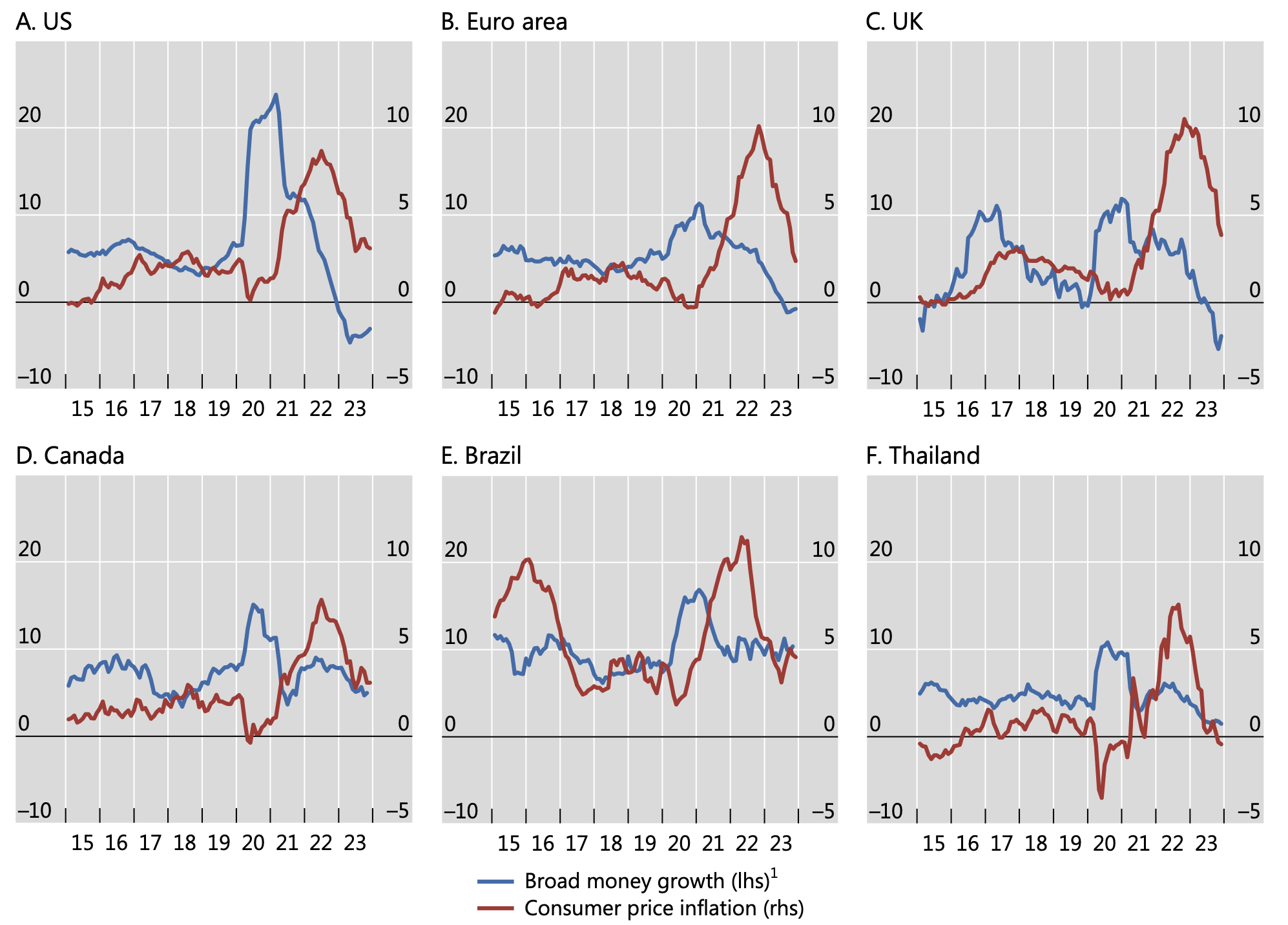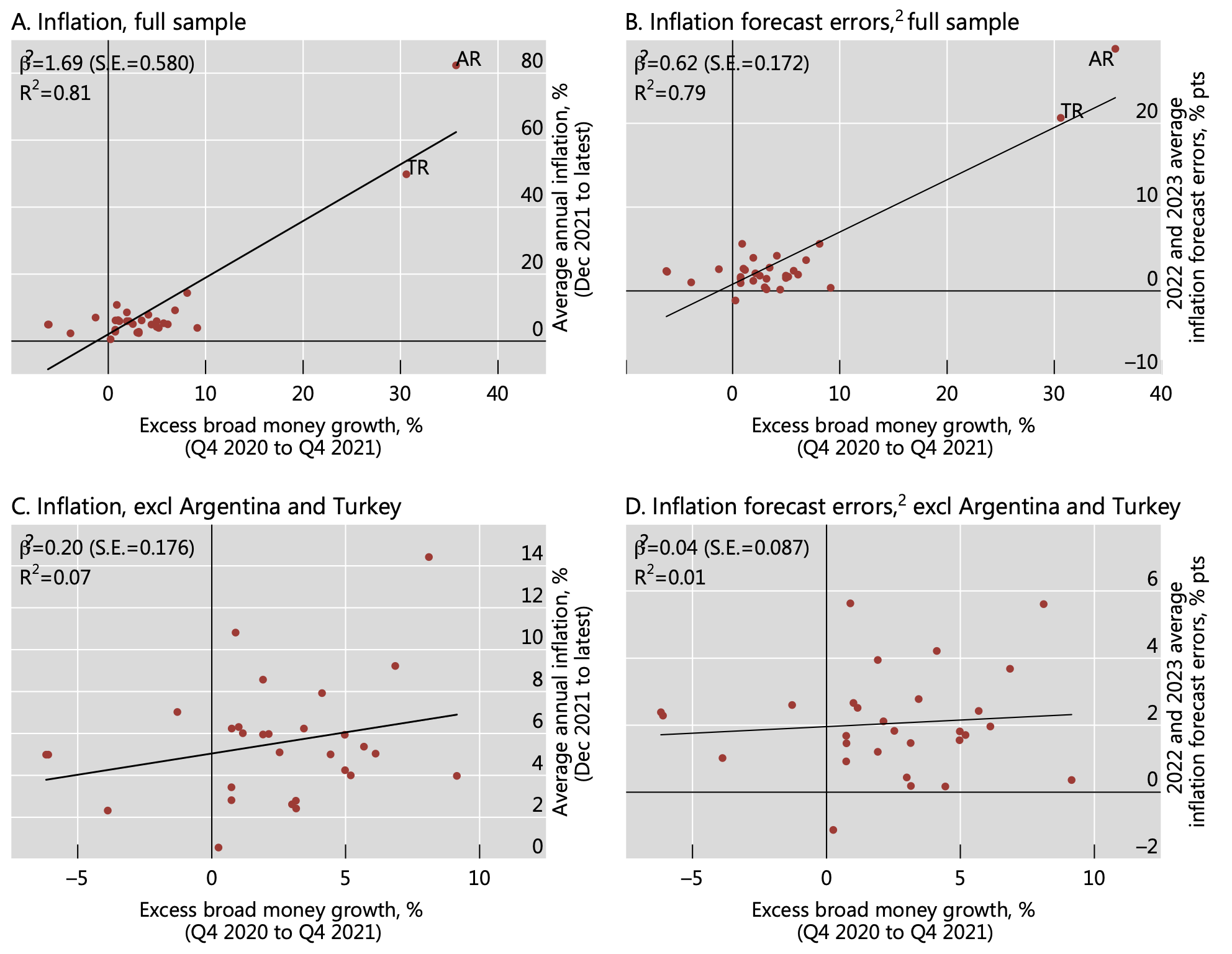Does money growth help to explain post-pandemic inflation gyrations? Monetary aggregates have gradually lost relevance since the heyday of monetary targeting in the 1970s and 1980s. As their link with inflation weakened, they largely disappeared from academic analysis (Laidler 2002) as well as from monetary policy design and implementation. More recently, however, they have enjoyed a revival, as the surprising resurgence of inflation in the aftermath of the pandemic grew hand in hand with increases in the money stock in a number of jurisdictions prominent in economic debates (Congdon 2022, Issing 2021, Laidler 2021, Jeffery 2021, King 2021) as well as more generally.
Figure 1 illustrates the co-movement of broad money growth and inflation for a number of jurisdictions. The country-specific panels show that there was a surge in money growth in all cases during 2020, followed by a flare-up of inflation in 2021–22. The panels also show that money growth slowed markedly in 2021, followed by a drop in inflation from mid-2022 onwards. These observations appear to point to a link between money growth and inflation outcomes in recent years. In this column, we provide some systematic cross-country evidence of the link, updating and extending the analysis in Borio et al. (2023a, see also Borio et al. 2024).
Figure 1 Money growth and inflation, year-on-year, in percent
Note: 1 Broad money is defined according to the national broad money definitions (M2 or M3).
Sources: Datastream Refinitiv, national data, BIS calculations.
The reference framework: a two-regime view of inflation and the money link
In considering the link between money growth and inflation, it is useful to think of inflation as a two-regime process, with transitions from the low- to the high-inflation regime that are potentially self-reinforcing (BIS 2022, Borio et al. 2023b). In the low-inflation regime, inflation mostly reflects the short-lived effects of largely uncorrelated sector-specific price change; in the high-inflation regime, sectoral price changes are more correlated. As inflation rises and the importance of the common component increases, price hikes become more similar and synchronised, acting as a kind of coordinating device for agents’ decisions. This, in turn, increases the likelihood of wage-price spirals.
The difference between the two regimes carries over to the link between money growth and inflation, helping to explain why monetary aggregates have fallen out of favour. Previous studies have found evidence that the link is strong when inflation is high, and weak when inflation is low (e.g. Laidler 2002, De Grauwe and Polan 2005, Sargent and Surico 2011, Gertler and Hofmann 2018).
Figure 2 illustrates these results. Using annual data from 1951 to 2021, panel A shows the long-run relationship between inflation and ‘excess money growth’ – the difference between money growth and real GDP growth
– in a large sample of advanced economies (AEs) and emerging market economies (EMEs). Figure 2 displays the relationship between these two variables based on non-overlapping ten-year averages.
When the observations from all countries are pooled, the standard relationship emerges clearly: there is a precisely estimated one-to-one link between excess money growth and inflation. But, as shown in panel B, if we split the observations into high- and low-inflation regimes using different ten-year average inflation rate thresholds, we see that this relationship exists only when the inflation threshold moves out of the low-inflation regime region. Moreover, as expected, the difference narrows noticeably as the inflation threshold increases further.
The result is intuitive. On theoretical grounds, one would expect money growth to be more closely linked to the common component of inflation, as this component is conceptually closest to ‘true inflation’, or a generalised increase in prices. And when inflation is low, the importance of this component in explaining the overall variability of price changes tends to be low relative to the idiosyncratic or sector-specific component.
A natural question then arises: is the post-pandemic inflation surge a reflection of the money growth–inflation link from Figure 2? And if yes, what would be the implications for the inflation outlook going forward, in particular for the risks of a transition to a high-inflation regime?
Figure 2 Inflation and money growth go hand in hand1
Notes: 1 Country-specific non-overlapping ten-year averages from 1951 to 2021 (subject to data availability). The sample covers: AR, AU, BR, CA, CH, CL, CN, CO, DK, EA, GB, HU, ID, IL, IN, JP, KR, MX, MY, NO, NZ, PE, PH, RU, SA, SE, SG, TH, TR, TW, US, and ZA. Broad money is defined according to the national broad money definitions (M2 or M3) and money plus quasi-money for PE, backdated with money and quasi-money data to get long series. Excess broad money growth is defined as the difference between the growth in broad money and the growth in real GDP.
2 The circled area in panel A shows a zoomed-in section where excess money growth and inflation are below 5%.
3 In panel B, slope coefficients from the regression of non-overlapping ten-year average inflation on non-overlapping ten-year average excess money growth, where the coefficient on excess money growth (as well as the intercept) is allowed to switch across the specified inflation threshold; the shaded area highlights the range of (ten-year average) inflation rates generally acknowledged as constituting a ‘low-inflation regime’.
Sources: ECB, IMF, OECD, Datastream Refinitiv, Global Financial Data, national data, BIS calculations.
Did money growth predict post-pandemic inflation?
There is evidence that money growth predicted inflation during the inflation surge of 2021–22. Across countries, there is a statistically and economically significant positive correlation between excess money growth in 2020 and average inflation in 2021 and 2022 (Figure 3, panel A). In fact, we cannot reject the hypothesis that the link is one to one.
In line with the historical evidence, the economic strength of the link becomes notably weaker when we exclude countries with very high inflation rates – Argentina and Turkey (panel C): the coefficient drops to 0.34. Even so, it remains statistically highly significant.
Figure 3 Money growth in 2020 and the 2021–22 inflation surge1
Notes: 1 The sample covers: AR, AU, BR, CA, CH, CL, CN, CO, DK, EA, HU, IL, IN, ID, JP, KR, MX, MY, NO, NZ, PH, RU, SA, SE, SG, TH, TR, TW, UK, US, and ZA. Broad money is defined according to the national broad money definitions (M2 or M3).
2 Inflation forecast errors for 2021 are calculated as the difference between actual CPI inflation in 2021 and the 2021 inflation forecasts from Consensus Economics of December 2020; inflation forecast errors for 2022 are calculated as the difference between actual CPI inflation in 2022 and the 2022 inflation forecasts from Consensus Economics of December 2021.
Sources: ECB, IMF, OECD, Consensus Economics, Datastream Refinitiv, national data, BIS.
The test can be made more demanding: could incorporating information about money growth have helped to improve the forecasts of professional economists over this period? This is a tougher test because these forecasts presumably contained all the information forecasters perceived as relevant.
The answer appears to be yes: the underprediction of inflation was greater for countries that saw higher excess money growth during the pandemic. Each one percentage point difference in the rate of excess money growth in 2020 across countries reduces the average 2021–22 inflation forecast error by 0.25 percentage points in the full sample (panel B) and by 0.15 percentage points when the two high-inflation countries are excluded (panel D).
The information content of excess money growth is robust to controlling for the post-pandemic rebound in economic activity as well as for the pandemic-related fiscal stimulus (Figure 4). If stronger rebounds naturally follow deeper recessions, regardless of the money path, money growth could spuriously capture the information content of the behaviour of output alone. Similarly, 2020 saw large fiscal deficits to counter the economic fallout of the pandemic, which might have spurred inflation in subsequent years. Money growth might proxy for these inflationary effects. That said, the link survives after controlling for confounding factors (panels A and B for inflation; panels C and D for inflation forecast errors).
Figure 4 Money growth in 2020 and the 2021–22 inflation surge, controlling for confounding factors1
Notes: 1 The sample covers: AU, BR, CA, CH, CL, CN, CO, DK, EA, HU, IL, IN, ID, JP, KR, MX, MY, NO, NZ, PE, PH, RU, SA, SE, SG, TH, TW, UK, US, and ZA. Broad money is defined according to the national broad money definitions (M2 or M3). The scatter charts show the link between 2020 excess money growth and 2021–22 average inflation conditional on the recovery from the Covid-19 recession, i.e. conditional on 2021–22 average real GDP growth (panels A and C) and on the 2020 fiscal deficit (panels B and D), so all variables are specified as residuals of a prior regression on the conditioning variable.
2 Inflation forecast errors for 2021 are calculated as the difference between actual CPI inflation in 2021 and the 2021 inflation forecasts from Consensus Economics of December 2020; inflation forecast errors for 2022 are calculated as the difference between actual CPI inflation in 2022 and the 2022 inflation forecasts from Consensus Economics of December 2021.
Sources: ECB, IMF, OECD, Consensus Economics, Datastream Refinitiv, national data, BIS.
So far, so good for the money growth-inflation hypothesis. But does the link persist? To examine this question, we move the window of the preceding analysis one year forward: we consider the correlation between excess money growth in 2021 and average inflation and average inflation forecast errors in 2022–23.
Here the picture is much more mixed. The correlation between excess money growth and both future inflation and inflation forecast errors remains intact for the full sample of countries (Figure 5, panels A and B), but is hardly visible once we drop the two high-inflation countries (panel C). In this smaller sample, the relationship is still positive but is not statistically significant. And for inflation forecast errors, the link vanishes (panel D). This indicates either that forecasters on this occasion incorporated the information content of money, or that it did not add value to the information set they used.
Figure 5 Money growth in 2021 and 2022–23 inflation dynamics1
Notes: 1 The sample covers: AR, AU, BR, CA, CH, CL, CN, CO, DK, EA, HU, IL, IN, ID, JP, KR, MX, MY, NO, NZ, PH, RU, SA, SE, SG, TH, TR, TW, UK, US, and ZA. Broad money is defined according to the national broad money definitions (M2 or M3).
2 Inflation forecast errors for 2021 are calculated as the difference between actual CPI inflation in 2022 and the 2022 inflation forecasts from Consensus Economics of December 2021; inflation forecast errors for 2023 are calculated as the difference between the annualised year-to-date inflation and the 2023 inflation forecasts from Consensus Economics of December 2022.
Sources: ECB, IMF, OECD, Consensus Economics, Datastream Refinitiv, national data, BIS.
Concluding considerations
The updated evidence provides nuance to our previous findings (Borio et al. 2023a). On one hand, it strengthens the robustness of the findings for the period 2021–22, when the inflation surge took place. The cross-country link survives when controlling not only for the post-pandemic rebound in economic activity, but also for the fiscal response to the pandemic. On the other hand, the new analysis casts doubt on the persistence of the link once inflation declines. When the window is rolled forward by one year, the link remains intact if the two high-inflation countries are retained in the sample, but is hardly visible if they are dropped.
What are the policy implications? The updated analysis confirms the relationship between the information content of money growth for inflation and the level of inflation itself: the inflation regime matters. At the same time, it underlines the difficulties in using that information reliably as inflation shifts across regimes. Judgment remains of the essence.
Authors’ note: We thank Charles Goodhart, Otmar Issing, David Laidler, Francesco Pappadia, and Hyun Song Shin for comments on an earlier version of this work. The views expressed are those of the authors and not necessarily the views of the BIS, the Federal Reserve Bank of Boston, the principals of the Board of Governors, or the Federal Reserve System. The authors are grateful to Alexis Maurin for excellent research assistance.
References
Bank for International Settlements (2022), “Inflation: a look under the hood”, BIS Annual Economic Report, June, 41–73.
Borio, C, B Hofmann and E Zakrajšek (2023a), “Does money growth help explain the recent inflation surge?”, BIS Bulletin, no. 67.
Borio, C, B Hofmann and E Zakrajšek (2024), “Money growth and the post-pandemic surge in inflation”, Revue d'économie financière, forthcoming.
Borio, C, M Lombardi, J Yetman and E Zakrajšek (2023b), “The two-regime view of inflation”, BIS Papers, no. 133, March.
Congdon, T (2022), “The case for restoring the role of monetary aggregates”, Central Banking, 8 August.
De Grauwe, P and M Polan (2005), “Is inflation always and everywhere a monetary phenomenon?”, Scandinavian Journal of Economics 107(2): 239–59.
Gertler, P and B Hofmann (2018), “Monetary facts revisited”, Journal of International Money and Finance 86: 154–70.
Issing, O (2021), “The return of inflation?”, Project Syndicate, 16 July.
Jeffery, C (2021), "Charles Goodhart on inflation targets, financial stability and the role of money”, Central Banking, 22 June.
King, M (2021), “Monetary policy in a world of radical uncertainty”, IIMR Conference Papers Series, November.
Laidler, D (2002), “Monetary policy without money: Hamlet without the ghost”, Macroeconomics, monetary policy and financial stability: Essays in honour of Charles Freedman, Bank of Canada, 111–34.
Laidler, D (2021), “Lucas (1972), A personal view from the wrong side of the subsequent fifty years”, Western University, Department of Economics, Research Reports, no. 2021-5.
Lucas, R (1980), “Two illustrations of the quantity theory of money”, American Economic Review 70(5): 1005–1014.
Sargent, T and P Surico (2011), “Two illustrations of the quantity theory of money: breakdowns and revivals”, American Economic Review 101(1): 109–28.











